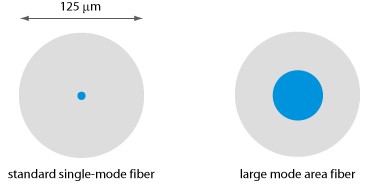หมวดหมู่
บล็อกล่าสุด
बड़े कोर फाइबर
फाइबर का कोर वह क्षेत्र है जिसमें प्रकाश निर्देशित होता है, यानी यह वेवगाइडिंग प्रभाव के लिए जिम्मेदार होता है। आमतौर पर, कोर थोड़ा बढ़ा हुआ अपवर्तक सूचकांक का क्षेत्र होता है, जिसे पूरी तरह से अलग ग्लास का उपयोग करके नहीं, बल्कि कुछ इंडेक्स-रेजिंग सामग्री के साथ ग्लास को डोपिंग करके प्राप्त किया जाता है। सिलिका फाइबर के मामले में , विशिष्ट सूचकांक-बढ़ाने वाले डोपेंट जर्मनिया (GeO2, जर्मेनोसिलिकेट फाइबर), फॉस्फोरस पेंटोक्साइड (P2O5, फॉस्फोसिलिकेट) और एल्यूमिना (Al2O3, एलुमिनोसिलिकेट) हैं। वैकल्पिक रूप से या इसके अतिरिक्त, क्लैडिंग के सूचकांक को कम किया जा सकता है उदाहरण के लिए फ्लोरीन या बोरॉन ऑक्साइड (B2O3) डोपिंग द्वारा। इंडेक्स-लोअरिंग एजेंटों का उपयोग कोर में भी किया जा सकता है यदि अन्य आवश्यक डोपेंट इंडेक्स अंतर को बहुत अधिक बनाते हैं।
Additional dopants are required for active fibers, i.e., for fibers which can be used for fiber amplifiers or lasers. In almost all cases, these dopants contain rare earth ions such as Er3+ (erbium), Yb3+ (ytterbium) or Nd3+ (neodymium). In addition to these ions, other ingredients are often used, e.g. for reducing quenching or photodarkening effects.
The waveguiding properties are determined by the refractive index profile, i.e., the increase in refractive index in the core relative to that of the cladding. For step-index profiles, the numerical aperture and the V number are frequently used parameters.
Although the fiber core is rotationally symmetrical for most fibers, there are methods to break this symmetry e.g. by using an elliptical core and/or by introducing asymmetric structures around the core. This can lead to strong birefringence (→ polarization-maintaining fibers) and even to polarization-dependent guidance (→ single-polarization fibers).
In most cases, the fiber core is located at the center of the fiber's cross-section, because this facilitates splicing, launching light, the use of fiber connectors and other fiber joints, etc. However, for double-clad fibers it can be very advantageous to use an off-centered core, because this can substantially improve the pump absorption. In rare cases, helical core fibers are used where the core winds around the fiber axis.
A large-core fiber is an optical fiber having a fiber core which is relatively large. It can be a multimode fiber or a single-mode fiber.
Large-core Multimode Fibers
Large-core multimode fibers have a core diameter which is well above the typically used 50 μm or 62.5 μm of telecom fibers – for example, 100 μm or even 400 μm. The core is often not much smaller than the fiber cladding (see Figure 1). The cladding diameter may substantially go beyond the usual 125 μm in order to realize even larger cores. The number of guided fiber modes is then usually very high.
Design of a large-mode multimode fiber with 105 μm core diameter and 125 μm cladding diameter.
Frequently, such fibers have a pure silica fiber core (rather than e.g. a germanosilicate core) and a fiber cladding with somewhat reduced refractive index, e.g. achieved with fluorine doping. For realizing a high numerical aperture, however, one may still use fibers with germanosilicate core.
Typical applications of large-core multimode fibers are the passive transport of light e.g. in the context of illumination, laser material processing or optical pumping of solid-state lasers.
Large-core Single-mode Fibers
यदि एक बड़ा-कोर फाइबर एकल-मोड फाइबर है , तो इसका एक बड़ा प्रभावी मोड क्षेत्र भी है । यहां, बड़े मोड क्षेत्र फाइबर शब्द अधिक सामान्य और अधिक उपयुक्त है, क्योंकि बड़े मोड क्षेत्र एक विशेष रूप से महत्वपूर्ण संपत्ति है: इसका परिणाम उच्च बीम गुणवत्ता के साथ संयुक्त गैर-रैखिक प्रभावों में होता है ।
सी एक मानक कोर आकार (जैसे 8 माइक्रोन व्यास) और एक बड़े कोर (50 माइक्रोन व्यास) के साथ नंगे ( अनकोटेड ) फाइबर की तुलना।

उन बड़े व्यास के तंतुओं के लिए, हमें फुजिकुरा 100 एम, शिन्हो एस -27 एलडीएफ इत्यादि जैसे एलडीएफ स्प्लिसर का उपयोग करने की आवश्यकता है ।
© ลิขสิทธิ์: SHINHO OPTICS LIMITED สงวนลิขสิทธิ์.